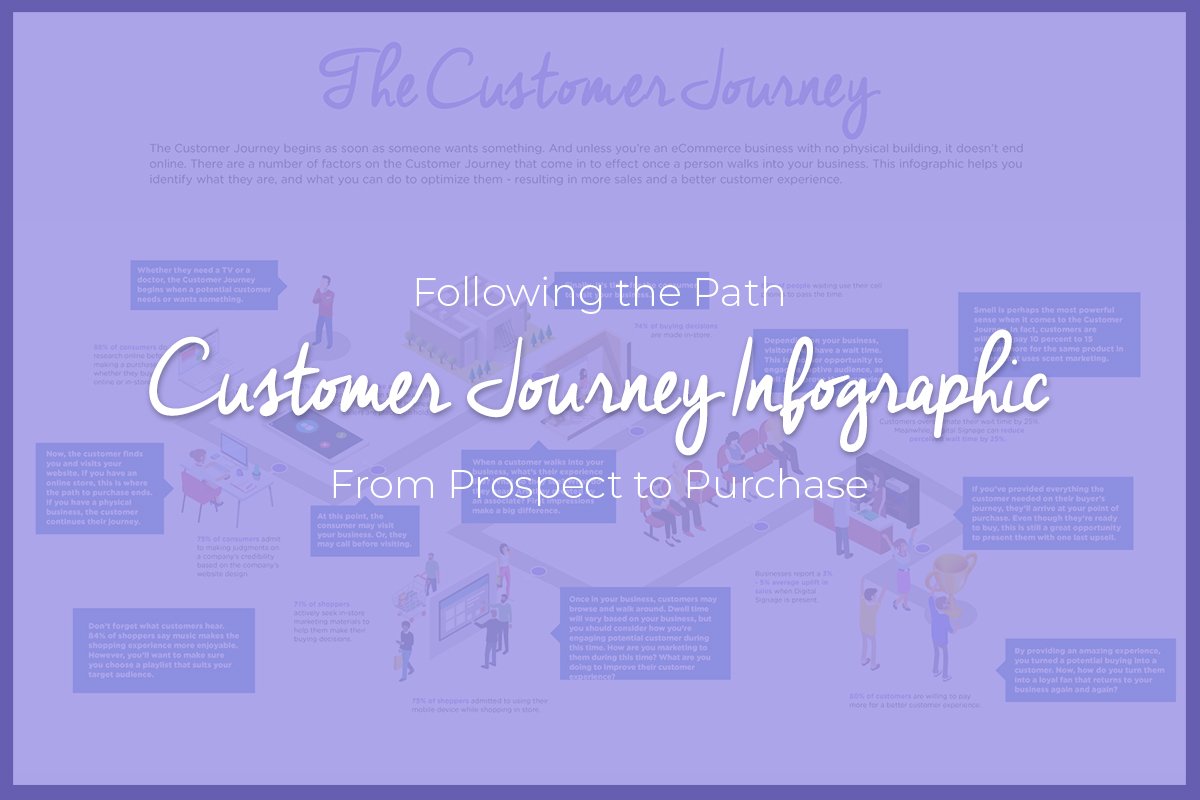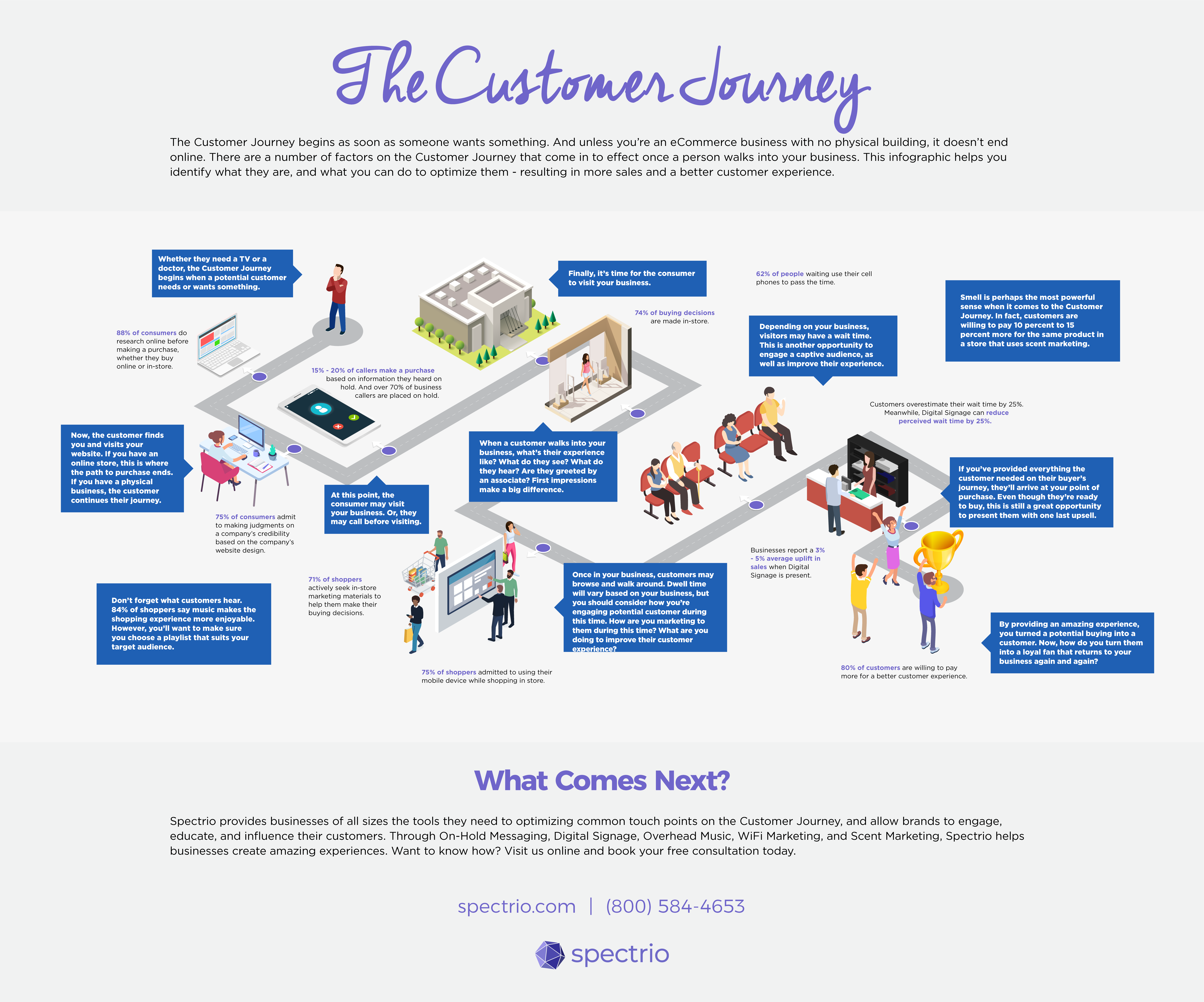The customer journey is the path that potential buyers take as they make their way to becoming paying customers. It outlines each step that customers take as they move through the awareness, engagement, consideration, purchase, and post-purchase phase of the buyer’s journey.
Understanding the customer journey is powerful for brands because it helps to identify:
- What branded touchpoints the customer comes in contact with
- What customers might be thinking and need along their journey
- Places along the path where you can create incentives that move customers to the next phase
- Places along the path where you can improve customer experiences and get customers to come back and re-enter the buying journey
To help you visualize the customer journey from start to finish, we created an infographic that follows the path of a typical shopper. Use the infographic to get an idea of how your ideal buyers move from being prospects to paying customers, and then use the rest of this post to dive deeper into how you can optimize and improve the path your prospects take on their way to making a purchase.
Click on the image to enlarge or share on social!
The In-Home Customer Journey
Whether they need a TV or a doctor, the customer journey begins when a potential customer needs or wants something. This realization usually happens outside of a store. The prospect is at home and realizes they have a need or want.
When customers have this realization, or awareness of their need or want, they typically go to their devices to search for solutions and research their options.
Eighty-eight percent (88%) of consumers do research online before making a purchase whether they online or in-store.
The research typically takes customers to a brand’s website where they can take the next step in their journey which is to either make an online purchase or plan their visit to a physical business location. The look and the feel of the website can have a direct impact on whether or not the customer takes the next step.
Seventy-five percent (75%) of consumers admit to making judgements on a company’s credibility based on the company’s website design.
In addition to using a website to research before their visit, a customer may also call the business. Businesses should make sure it’s easy for customers to call by adding click-to-call buttons on their site.
If the customer calls and is placed on hold (which many are — 70% of business callers are placed on hold), on-hold messaging creates another touchpoint that can be used to encourage the customer to visit and make a purchase during their trip.
Fifteen to twenty percent (15-20%) of callers make a purchase based on information they heard on hold.
Finally, it’s time for the consumer to visit a business.
The In-store Customer Journey
When a customer walks into a business, the next phase and possibly the most important part of their customer journey begins.
Seventy-four percent (74%) of buying decisions are made in-store.
At this point, brands need to make sure that customers have an amazing first impression when they walk into a store. Audit your store’s first impression by asking:
- What is the experience like?
- What do customers see?
- What do they hear?
- Are they greeted by an associate?
- How are you marketing to them during this time?
- What are you doing to improve their customer experience?
Don’t overlook the value of customer experiences. It is closely tied to your bottom line.
Eighty percent (80%) of customers are willing to pay more for a better customer experience.
Need help with auditing your in-store experience? Download our free Customer Experience Audit Worksheet.
Next to improving customer experience, also employ in-store marketing tactics that sell to shoppers. Use in-store marketing tools like digital signage, overhead music, and WiFi marketing to catch attention, decrease perceived wait-times, and upsell.
- Businesses report a 3-5% average uplift in sales when digital signage is present. Add high-quality on-screen content to engage and sell to customers.
- Seventy-five percent (75%) of shoppers admitted to using their mobile device while shopping in store. Use WiFi marketing to connect with shoppers on their devices while shopping in your store.
- Customers overestimate their wait time by 25%. Meanwhile, digital signage can reduce perceived wait time by 25%. Use digital waitboards to make your customer waits feel shorter and less stressful.
Keep in mind that customer experience is tied to all five senses. This includes smell. In fact, smell is perhaps the most powerful sense when it comes to the customer journey, so use scent marketing to create a pleasant shopping experience.
Customers are willing to pay 10-15% more for the same product in a store that uses scent marketing.
At this point, if you’ve provided everything the customer needed on their buyer’s journey, they’ll arrive at your point of purchase. Even though they’re ready to buy, this is still a great opportunity to present them with one last upsell.
Place digital menu boards near your check-out to introduce new products, highlight limited-time offers, promote packages, and otherwise use digital signage to upsell customers.
Remember that the customer journey doesn’t end when a purchase is made.
You don’t want the customer relationship to stop here. Instead, you want to attempt to get the customer to rejoin the journey and come back to your business again. So, end the experience by creating remarketing opportunities that will allow you to pull the customer back again. Collect customer contact information so you can send messages to encourage customers to return and start the process all over again.
Optimize Your Customer Journey with In-Store Marketing
By following this example of a customer journey, you can outline the path your customers take on their way to doing business with you. Outline each touchpoint your customers experience on their buyer’s journey and then use in-store marketing tools to connect with them at each stage.
Spectrio provides businesses of all sizes the tools they need to optimize common touchpoints on the customer journey. Contact us today to request a free demo and learn how you can use on-hold messaging, digital signage, overhead music, WiFi marketing, and scent marketing to engage, educate, and influence customers during the buyer’s journey.

